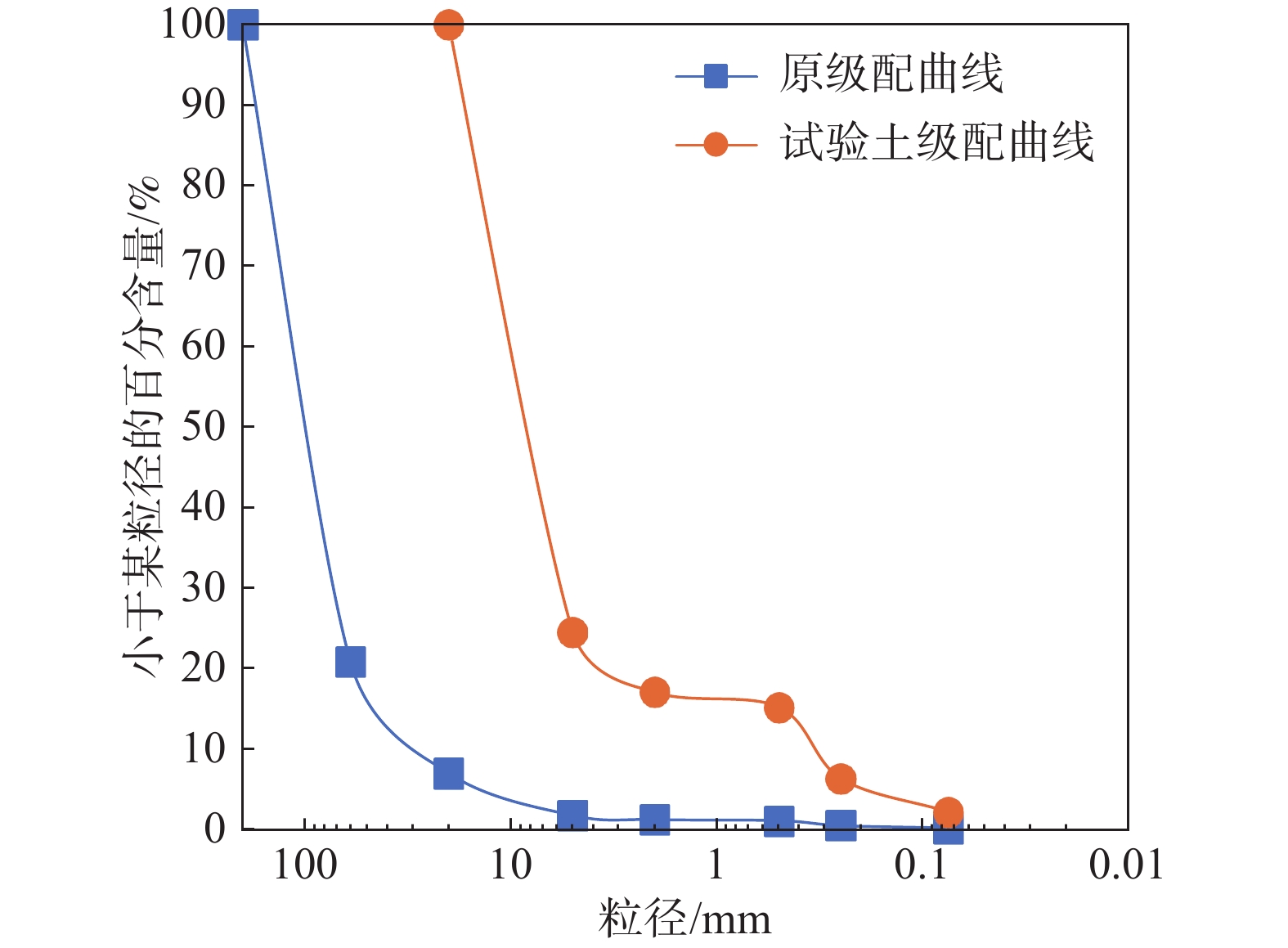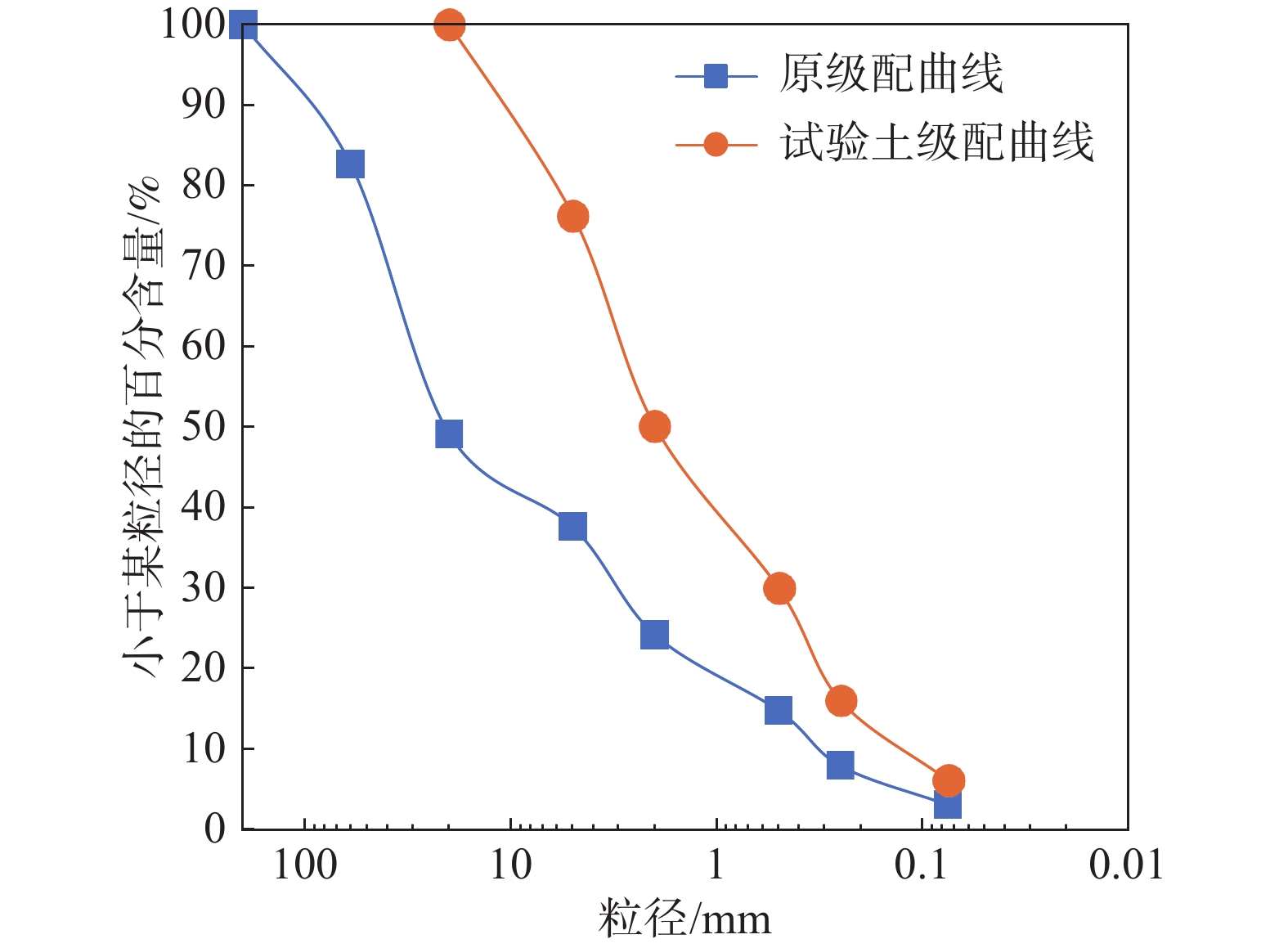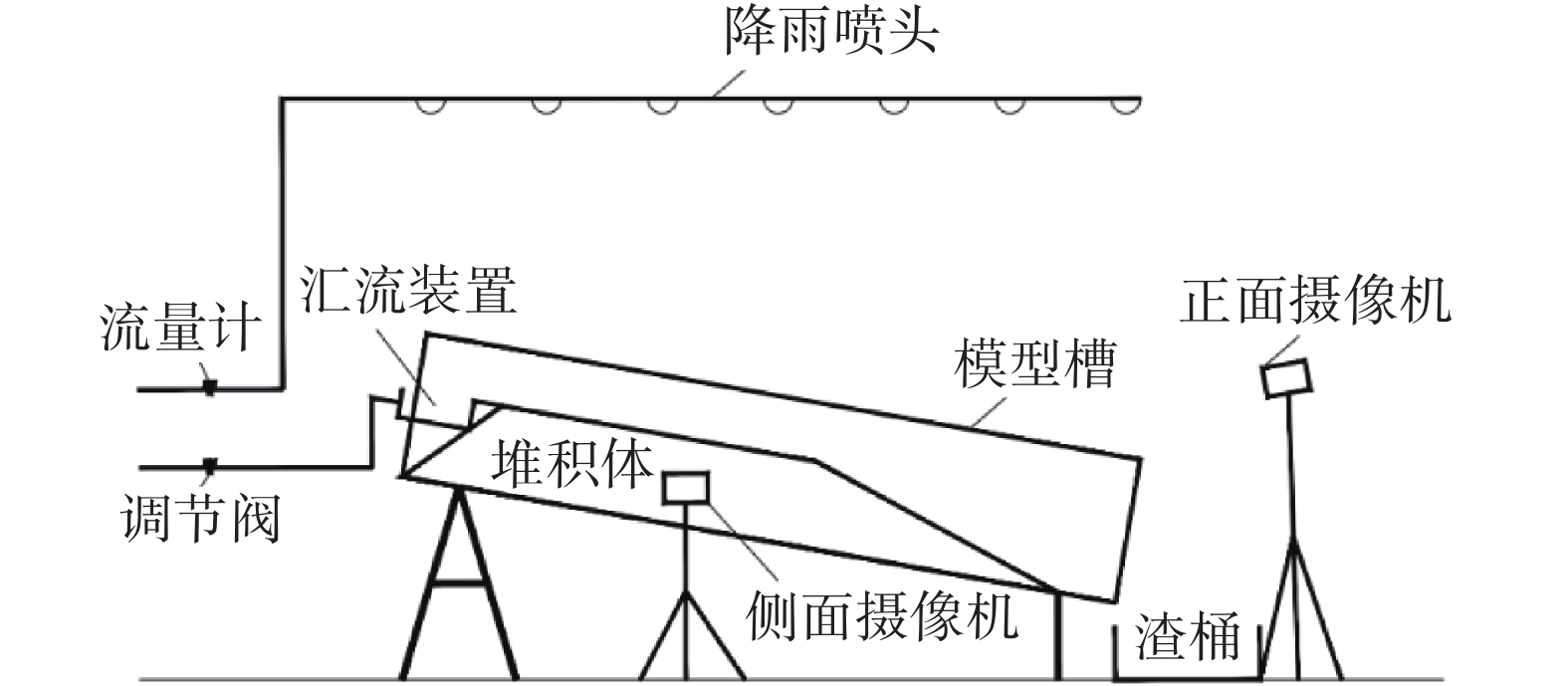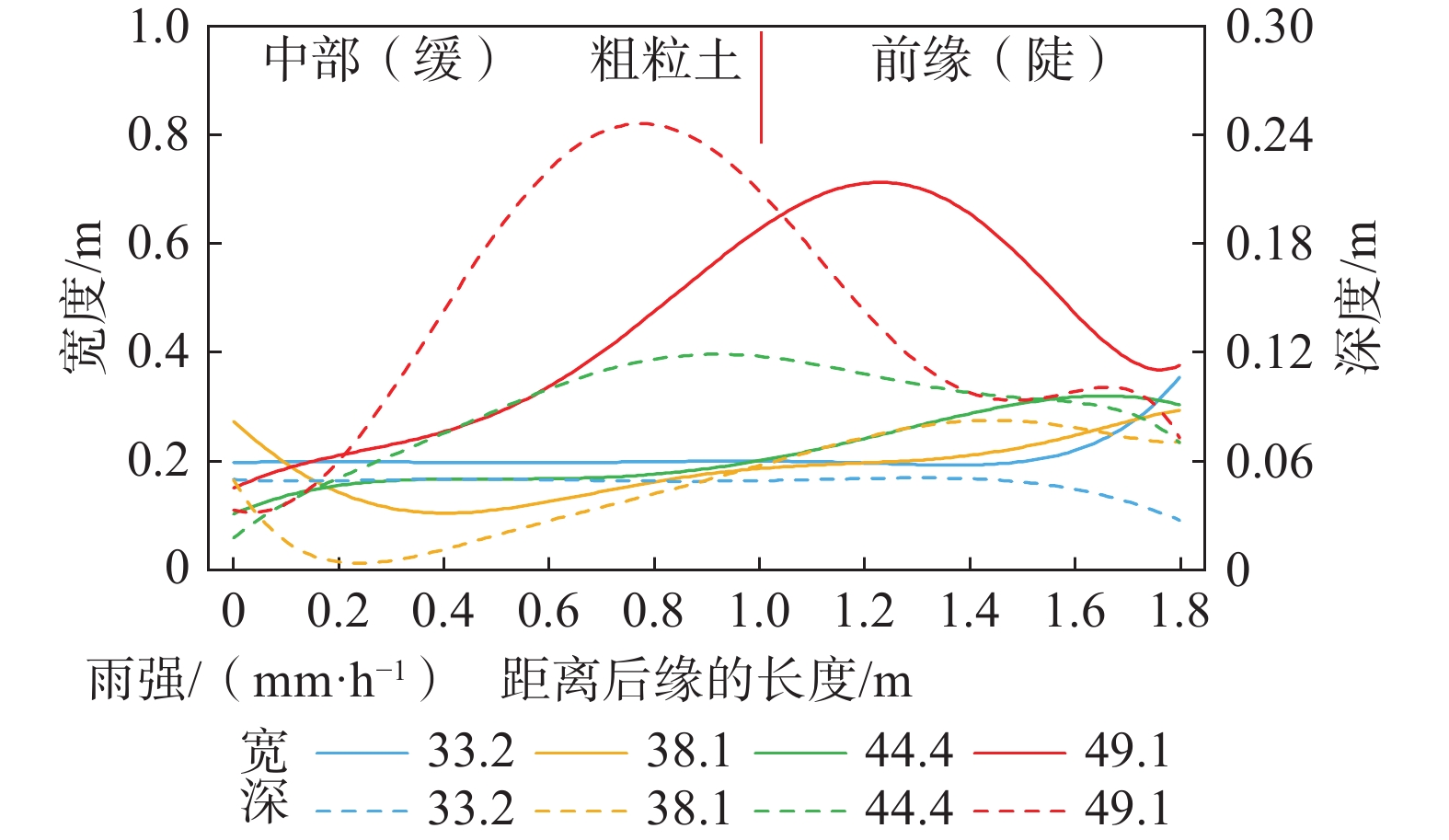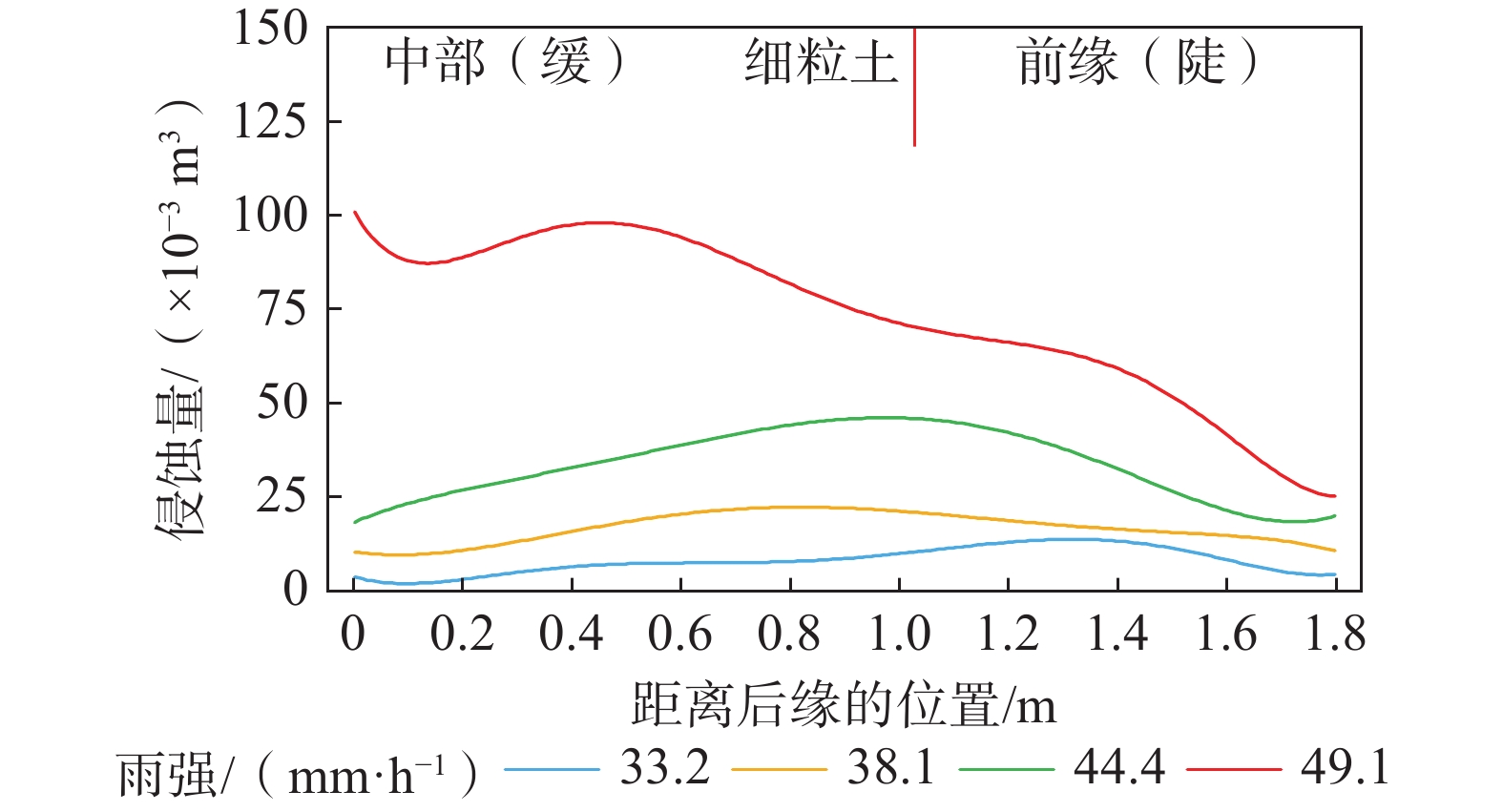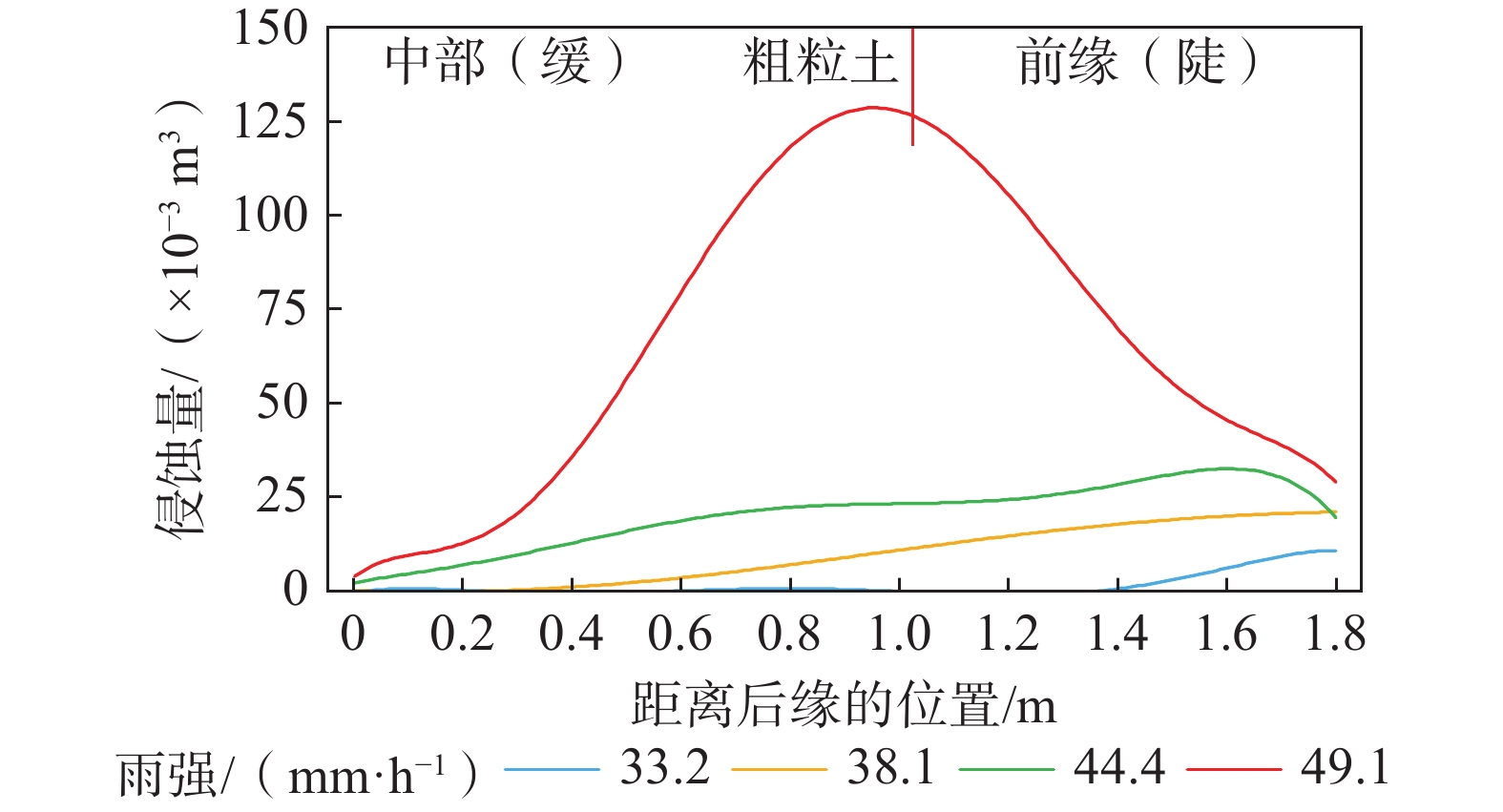Dynamic reserves of evaluation model for materials source in the channel based on fractal theory and model test
-
摘要:
汶川地震后,大量松散固体物源堆积在沟道中,使沟道泥石流发生的概率激增。准确的计算泥石流沟道物源的动储量一直是泥石流物源统计的难点。文章以七盘沟下游主沟段沟道物源为研究对象,在实地勘查、资料收集的基础上,以室内模型试验为研究手段,引入分形理论将复杂的土体粒度成分用分维值定量描述,研究不同沟道堆积体在不同降雨作用下的侵蚀规律,建立以降雨强度和分维度为双影响因子的动储量评价模型。研究表明:粗粒土不易起动,但在充足的水动力条件下,侵蚀作用会成倍放大;上细下粗土发生泥石流时侵蚀变化和总的侵蚀规模较小,这种粒序分布形式有益于沟道的稳定;上粗下细土与粗粒土的侵蚀现象类似,但发生大规模泥石流的降雨阈值低于粗粒土;沟道物源中,侵蚀作用效应的排序为:溯源侵蚀>下切侵蚀>侧缘侵蚀>潜蚀;文章所拟合的公式适用于宽缓型沟道泥石流,对于窄陡型沟道泥石流存在一定的局限性。
Abstract:After the Wenchuan earthquake, many loose solid sources accumulated in the channel, which increased the probability of debris flow. It was difficult to calculate the dynamic reserves of debris flow sediment source accurately. Based on field investigation, data collection and laboratory model test, this paper introduced the fractal theory to quantitatively describe the complex soil particle size composition with fractal dimension, and studied the erosion regular of different deposits in channels under different rainfall effects. A dynamic reserve evaluation model with rainfall intensity and fractal dimension as double influencing factors was established. The results show: Coarse-grained soil is not easy to start, but under sufficient hydrodynamic conditions, erosion will be multiplied; When debris flow occurs, the erosion change and total erosion scale of "fine-grained on coarse-grained soil" are small, and which is beneficial to the stability of channel; The erosion phenomenon of "coarse-grained on fine-grained soil" is similar to that of coarse-grained soil, but the rainfall threshold of large-scale debris flow is lower than coarse-grained soil; For materials source in the channel, the order of erosion effect is headward erosion > shear erosion > lateral erosion > subsurface erosion; The formula fitted in this paper is suitable for the wide and slow channel of debris flow, but it has some limitations for the narrow and steep channel.
-
Key words:
- debris flow /
- the materials source in channel /
- dynamic reserves /
- model test /
- fractal theory
-

-
表 1 模型试验降雨条件
Table 1. Rainfall conditions of the model test
雨频/% 雨强/(mm∙h−1) 前期降雨用时/s 径流/(L∙h−1) 10 33.2 359 406.8 5 38.1 341 511.4 2 44.4 320 648.2 1 49.1 306 752.4 表 2 “7·10”后沟道物源颗粒累积百分含量
Table 2. Cumulative percentage of particles in the channel after “7·10”
编号 颗粒累积/% 200 60 20 5 2 0.5 0.25 0.075 ZG1 100 21.7 7.2 1.3 1.0 0.9 0.4 0.2 ZG2 100 16.9 5.9 1.4 1.7 1.4 0.5 0.2 ZG3 100 22.9 6.9 1.4 0.9 0.8 0.4 0.10 平均 100 20.8 7.0 1.7 1.2 1.1 0.4 0.2 表 3 “8·20”后沟道物源颗粒累积百分含量
Table 3. Cumulative percentage of particles in the channel after “8·20”
编号 颗粒累积/% 200 60 20 5 2 0.5 0.25 0.075 ZG1 100 81.3 43.7 32.9 22.6 9.5 5.2 1.1 ZG2 100 79.9 53.0 40.6 33.3 17.0 7.3 4.1 ZG3 100 86.7 50.9 39.3 26.7 17.8 11.2 3.9 平均 100 82.6 49.2 37.6 27.5 14.8 7.9 3.0 表 4 试验土分维值
Table 4. Fractal dimension of test soil
试验堆积体 分维值D 范围 类型 “7·10”粗粒土 2.250 <2.60 块碎石土 “8·20”细粒土 2.639 2.60≤D<2.82 碎石土 双层上细下粗 2.522 <2.60 块碎石土 双层上粗下细 2.596 <2.60 块碎石土 注:其中分维D越小,粒度越粗,分维D越大,粒度越细。 表 5 单因素对照试验设计方案
Table 5. Single factor-controlled trial design scheme
编号 堆积体
分维D降雨强度
/(mm∙h-1)编号 堆积体
分维D降雨强度
/(mm∙h-1)1-1 2.639 33.2 3-1 2.522 33.2 1-2 38.1 3-2 38.1 1-3 44.4 3-3 44.4 1-4 49.1 3-4 49.1 2-1 2.250 33.2 4-1 2.596 33.2 2-2 38.1 4-2 38.1 2-3 44.4 4-3 44.4 2-4 49.1 4-4 49.1 表 6 沟道侵蚀数据统计
Table 6. Data statistics of the channel erosion
D q/(mm∙h−1) V侵/m3 D q/(mm∙h−1) V侵/m3 2.639 33.2 0.015 90 2.522 33.2 0.003 11 38.1 0.033 10 38.1 0.020 63 44.4 0.066 21 44.4 0.045 94 49.1 0.145 78 49.1 0.062 91 2.250 33.2 0.002 95 2.596 33.2 0.001 90 38.1 0.019 07 38.1 0.020 91 44.4 0.039 63 44.4 0.116 03 49.1 0.131 33 49.1 0.132 82 表 7 雨强计算
Table 7. Calculation of rain intensity
频率 暴雨均值
H/(mm∙h−1)变差系数
CV模比系数
Kp暴雨设计值
Hp/(mm∙h−1)2% 22 0.35 1.92 42.2 5% 1.67 36.7 10% 1.47 32.3 20% 1.26 27.7 表 8 锄头沟“8·20”后沟道物源颗粒累积百分含量
Table 8. Cumulative percentage of particles in Chutougou after “8·20”
取样 颗粒累积/% 200 50 20 5 2 0.5 0.25 0.075 S1 100 40.1 32.8 28.3 21.7 12.6 9.2 1.4 S2 100 59.4 38.5 32.9 21.3 9.5 6.2 1.1 S3 100 65.2 46.4 41.4 31.7 16.6 11.7 2.1 平均 100 54.8 39.0 34.2 24.9 12.9 9.0 1.5 表 9 本文拟合计算结果
Table 9. The results of the fitting calculations in this paper
沟道 D 雨频 降雨强度
/(mm∙h-1)流通堆积区
/km侵蚀量
/(104 m3)锄头沟 2.572 20% 27.7 4.3 12.75 10% 32.3 24.46 5% 36.7 45.58 2% 42.2 99.23 七盘沟 2.250 20% 28.0 3.9 10.56 10% 33.2 22.03 5% 38.1 44.09 2% 44.4 107.49 表 10 动储量计算
Table 10. Dynamic reserve calculation
沟道 设防标准 动储量/(104 m3) 均值/(104 m3) 锄头沟 V5%+2V10%+3V20% 132.75 122.91 3V5% 136.74 V2% 99.23 七盘沟 V5%+2V10%+3V20% 119.83 119.86 3V5% 132.27 V2% 107.49 -
[1] XIONG J,TANG C,CHEN M,et al. Long-term changes in the landslide sediment supply capacity for debris flow occurrence in Wenchuan County,China[J]. CATENA,2021,203:105340. doi: 10.1016/j.catena.2021.105340
[2] 方群生,唐川,王毅,等. 汶川极震区泥石流动储量与总物源量计算方法研究[J]. 防灾减灾工程学报,2016,36(6):1008 − 1014. [FANG Qunsheng,TANG Chuan,WANG Yi,et al. A calculation method for predicting dynamic reserve and the total amount of material source of the debris flows in the Wenchuan meizoseismal area[J]. Journal of Disaster Prevention and Mitigation Engineering,2016,36(6):1008 − 1014. (in Chinese with English abstract) doi: 10.13409/j.cnki.jdpme.2016.06.023
[3] JAKOB M,BOVIS M,ODEN M. The significance of channel recharge rates for estimating debris-flow magnitude and frequency[J]. Earth Surface Processes and Landforms,2005,30(6):755 − 766. doi: 10.1002/esp.1188
[4] 乔建平,黄栋,杨宗佶,等. 汶川地震极震区泥石流物源动储量统计方法讨论[J]. 中国地质灾害与防治学报,2012,23(2):1 − 6. [QIAO Jianping,HUANG Dong,YANG Zongji,et al. Statistical method on dynamic reserve of debris flow's source materials in meizoseismal area of Wenchuan earthquake region[J]. The Chinese Journal of Geological Hazard and Control,2012,23(2):1 − 6. (in Chinese with English abstract) doi: 10.3969/j.issn.1003-8035.2012.02.001
[5] CHANG C W,LIN P S,TSAI C L. Estimation of sediment volume of debris flow caused by extreme rainfall in Taiwan[J]. Engineering Geology,2011,123(1/2):83 − 90.
[6] NI H Y. Experimental study on initiation of gully-type debris flow based on artificial rainfall and channel runoff[J]. Environmental Earth Sciences,2015,73(10):6213 − 6227. doi: 10.1007/s12665-014-3845-x
[7] 林斌,张友谊,罗珂,等. 沟道松散物质起动模型试验及冲出量预测—四川省以北川青林沟为例[J]. 人民长江,2019,50(5):113 − 118. [LIN Bin,ZHANG Youyi,LUO Ke,et al. Model test of start-up of loose material in gully and runout volume prediction:Case of Qinglin ditch in Sichuan Province[J]. Yangtze River,2019,50(5):113 − 118. (in Chinese with English abstract) doi: 10.16232/j.cnki.1001-4179.2019.05.021
[8] 张静,田述军,侯鹏鹂. 基于面积-高程和面积-坡度积分的泥石流物质供给能力分析[J]. 中国地质灾害与防治学报,2021,32(4):9 − 16. [ZHANG Jing,TIAN Shujun,HOU Pengli. The material supply ability analysis of debris flows based on areahypsometric integral and area-gradient integral[J]. The Chinese Journal of Geological Hazard and Control,2021,32(4):9 − 16. (in Chinese with English abstract) doi: 10.16031/j.cnki.issn.1003-8035.2021.04-02
[9] 张田田, 杨为民, 万飞鹏. 浑河断裂带地质灾害发育特征及其成因机制[J]. 吉林大学学报(地球科学版),2022,52(1):149 − 161. [ZHANG Tiantian, YANG Weimin, WAN Feipeng. Characteristics and formation mechanism of geohazards in Hunhe fault zone[J]. Journal of Jilin University (Earth Science Edition),2022,52(1):149 − 161. (in Chinese with English abstract)
[10] 胡卸文. 无泥型软弱层带物理力学特性[M]. 成都: 西南交通大学出版社, 2002
HU Xiewen. Physical and mechanical properties of mudless weak zone[M]. Chengdu: Southwest Jiaotong University Press, 2002. (in Chinese)
[11] 潘华利,安笑,邓其娟,等. 泥石流松散固体物源研究进展与展望[J]. 科学技术与工程,2020,20(24):9733 − 9741. [PAN Huali,AN Xiao,DENG Qijuan,et al. Progress and prospects of research on debris flow solid source[J]. Science Technology and Engineering,2020,20(24):9733 − 9741. (in Chinese with English abstract) doi: 10.3969/j.issn.1671-1815.2020.24.007
[12] 魏玉虎,胡卸文,齐光辉. 分形理论在土体粒度成分特征评价中的应用[J]. 安徽地质,2006,16(2):120 − 122. [WEI Yuhu,HU Xiewen,QI Guanghui. Application of fractal theory to evaluation of features of grain size composition of soil mass[J]. Geology of Anhui,2006,16(2):120 − 122. (in Chinese with English abstract) doi: 10.3969/j.issn.1005-6157.2006.02.008
[13] 游勇, 柳金峰, 欧国强. 泥石流常用排导槽水力条件的比较[J]. 岩石力学与工程学报, 2006, 25(增刊1): 2820 − 2825
YOU Yong, LIU Jinfeng, OU Guoqiang. Comparison of hydraulic conditions among usual debris flow drainage canal[J]. Chinese Journal of Rock Mechanics and Engineering, 2006, 25(Sup 1): 2820 − 2825. (in Chinese with English abstract)
[14] 李书钦,高建恩,邵辉,等. 选沙对水力侵蚀比尺模拟试验侵蚀过程相似的影响[J]. 水土保持学报,2009,23(3):6 − 10. [LI Shuqin,GAO Jianen,SHAO Hui,et al. Effects of model material selection on the similarity of erosion processes in hydraulic erosion simulation experiment[J]. Journal of Soil and Water Conservation,2009,23(3):6 − 10. (in Chinese with English abstract) doi: 10.3321/j.issn:1009-2242.2009.03.002
[15] 郭朝旭,崔鹏. 宽级配弱固结土体内细颗粒迁移规律研究评述[J]. 山地学报,2017,35(2):179 − 186. [GUO Chaoxu,CUI Peng. Fine particle migration in wide grading and poorly consolidated soil:An overview[J]. Mountain Research,2017,35(2):179 − 186. (in Chinese with English abstract) doi: 10.16089/j.cnki.1008-2786.000210
[16] 黄海,刘建康,杨东旭. 泥石流容重的时空变化特征及影响因素研究[J]. 水文地质工程地质,2020,47(2):161 − 168. [HUANG Hai,LIU Jiankang,YANG Dongxu. A study of the characteristics and influencing factors of spatial-temporal changes in the debris flow density[J]. Hydrogeology & Engineering Geology,2020,47(2):161 − 168. (in Chinese with English abstract) doi: 10.16030/j.cnki.issn.1000-3665.201907024
[17] 万飞鹏, 杨为民, 邱占林, 等. 甘肃岷县纳古呢沟滑坡-泥石流灾害链成灾机制及其演化[J/OL]. 中国地质, 2022: 1 − 19. (2022-06-22). https://kns.cnki.net/kcms/detail/11.1167.p.20220621.1148.008.html.
WAN Feipeng, YANG Weimin, QIU Zhanlin, et al. Disaster mechanism and evolution of Nagune gully landslide-debris flow disaster chain in Minxian County, Gansu Province[J/OL]. Geology in China, 2022: 1 − 19. (2022-06-22). https://kns.cnki.net/kcms/detail/11.1167.p.20220621.1148.008.html.(in Chinese with English abstract)
[18] 黄健, 胡卸文, 金涛, 等. 四川西昌“3·30”火烧区响水沟火后泥石流成灾机理[J]. 中国地质灾害与防治学报,2022,33(3):15 − 22. [HUANG Jian, HU Xiewen, JIN Tao, et al. Mechanism of the post-fire debris flow of the Xiangshui gully in “3·30” fire area of Xichang, Sichuan Province[J]. The Chinese Journal of Geological Hazard and Control,2022,33(3):15 − 22. (in Chinese with English abstract)
-



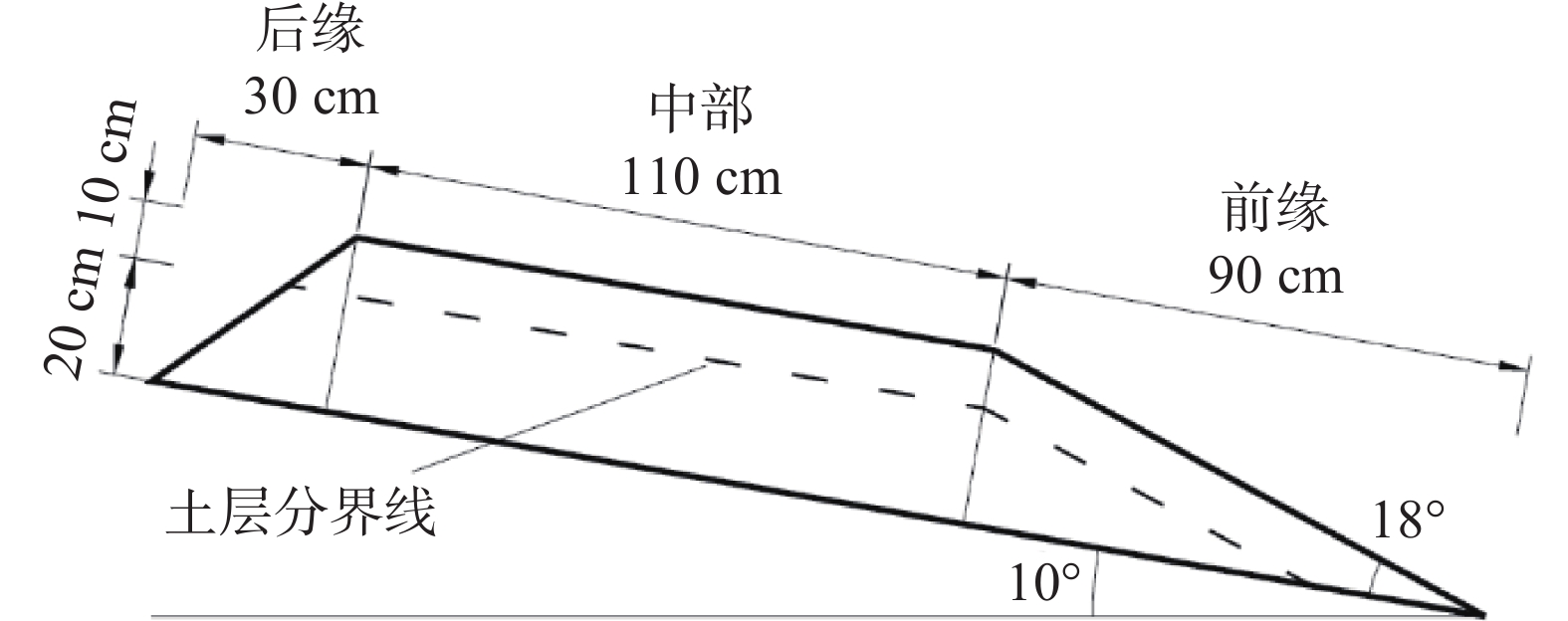
 下载:
下载:

